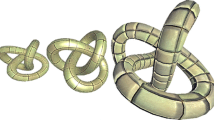Abstract
In this paper, we focus on a dynamically selective performance optimization method for mobile 3D graphics applications under n-screen service environment. Thus, an effective solution to enhance the performance is required to support real time processing under limited network bandwidth. This method can be employed to apply quality loss techniques that trade the quality within the range of tolerance over performance. First, we describe performance optimization methods for mobile graphics applications in 2 dimensions: Graphic Processing Unit (GPU) performance and image quality. Second, we present an adaptive level-of-detail (LOD) configuration method for graphics applications via OpenGL ES API level. Third, we show how OpenGL ES library hooking method can be employed to apply quality loss techniques that trade quality over performance. Last, we argue that OpenGL ES library hooking method is crucial to achieve higher performance, since it can be used in common android phones without any source code modification of applications. Overall, the experimental result shows that the proposed technique allows 24 % of performance improvement for all applied methodologies, and 4 % improvement for some selected methodologies while causing around 14 and 2 % of quality degradation, respectively. Thus, our approach can support an acceptable trade-off by determining the level of reduced quality that would lead to the desired performance improvements of the mobile GPU.














Similar content being viewed by others
References
Chen, Y. -J., Su, J. -C., Chang, C. -M., Lu, Y. -C., & Chien, S. -Y. (2012) Configurable pixel shader workload reduction technique for mobile gpus. In IEEE 1st global conference on consumer electronics (GCCE), 2012. IEEE, 2012, pp. 44–48.
Chu, S. -L., Hsiao, C. -C., & Chen, C. -Y., A dual-mode unified shader with frame-based dynamic precision adjustment for mobile gpus. In IFIP 9th international conference on embedded and ubiquitous computing (EUC), 2011. IEEE, 2011, pp. 158–165.
Sitthi-Amorn, P., Modly, N., Weimer, W., & Lawrence, J. (2011). Genetic programming for shader simplification. ACM Transactions on Graphics (TOG), 30(6), 152.
Ramos, F., Ripolles, O., & Chover, M. (2014). Efficient visualization of 3d models on hardware-limited portable devices. Multimedia Tools and Applications, 73(2), 961–976.
Luebke, D. P. (2003). Level of detail for 3D graphics. Burlington: Morgan Kaufmann.
Cohen, J., Luebke, D., Duca, N., & Schubert, B. (2003) Glod: A geometric level of detail system at the opengl api level. In Proceedings of the 14th IEEE visualization 2003 (VIS’03). IEEE Computer Society, 2003, p. 85.
McCaffrey, J. (2012). Exploring mobile vs. desktop opengl performance 24. OpenGL Insights, 337, 341.
Olano, M., Kuehne, B., & Simmons, M. (2003) Automatic shader level of detail. In Proceedings of the ACM SIGGRAPH/EUROGRAPHICS conference on Graphics hardware. Eurographics Association, 2003, pp. 7–14.
Fernando, R., Harris, M., Wloka, M., & Zeller, C. (2004) Programming graphics hardware. Eurographics (Tutorial)
Botsch, M., Hornung, A., Zwicker, M., & Kobbelt, L. (2005). High-quality surface splatting on today’s gpus. In Eurographics/IEEE VGTC symposium proceedings on point-based graphics, 2005. IEEE, 2005, pp. 17–141.
Thing, V. L., Subramaniam, P. P., Tsai, F. S., & Chua, T. -W. (2011) Mobile phone anomalous behaviour detection for real-time information theft tracking. In The second international conference on technical and legal aspects of the e-Society, CYBERLAWS 2011, 2011, pp. 7–11.
Apitrace, Tools for tracing OpenGL, Direct3D, and other graphics APIs. https://github.com/apitrace/apitrace, 2013.
Igehy, H., Eldridge, M., & Proudfoot, K. (1998). Prefetching in a texture cache architecture. In: Proceedings of the ACM SIGGRAPH/EUROGRAPHICS workshop on Graphics hardware. ACM, New York, p. 133.
Lacroute P., & Levoy, M. (1994). Fast volume rendering using a shear-warp factorization of the viewing transformation. In Proceedings of the 21st annual conference on computer graphics and interactive techniques. ACM, New York, pp. 451–458.
Cantlay, I. (2005). Mipmap-level measurement. GPU Gems II, pp. 437–449
Green, S. (2005). The opengl framebuffer object extension. In Game developers conference, 2005.
Wright, R. S., Haemel, N., Sellers, G. M., & Lipchak, B. (2010). OpenGL SuperBible: Comprehensive tutorial and reference. New York: Pearson Education.
Xiong, W., Wang, X., & Zhu, M. (2011). Study of lod terrain rendering algorithm based on gpu. In IET international communication conference on wireless mobile and computing (CCWMC 2011). IET, 2011, pp. 476–481.
Munshi, A., Ginsburg, D., & Shreiner, D. (2008). OpenGL ES 2.0 programming guide. New York: Pearson Education.
Hildenbrand, J. (2014). Latest platform numbers are in: KitKat climbs to 8.5%. http://www.androidcentral.com/latest-platform-numbers-are-kitkat-climbs-85, May 2014.
Shreiner, D., Sellers, G., Kessenich, J. M., & Licea-Kane, B. M. (2013). OpenGL programming guide: The Official guide to learning OpenGL, version 4.3. Boston: Addison-Wesley.
Rightware Basemark GUI. http://www.rightware.com/benchmarks, 2013.
Rightware, Basemark ES 2.0 Taiji. http://www.rightware.com/benchmarks, 2013.
Kishonti Informatics Ltd, GFXBench 2.5 Egypt HD. http://gfxbench.com/, 2013.
Kishonti Informatics Ltd, GLBenchmark 2.1.4 Egypt. http://gfxbench.com/, 2013.
Tactel AB, Electopia. https://play.google.com/store/apps/developer?id=Tactel+AB, 2013.
Qualcomm, Adreno Profiler Version 2.7. https://developer.qualcomm.com/mobile-development/maximize-hardware/mobile-gaming-graphics-adreno/tools-and-resources, 2013.
Arjunan, R. V. (2012). Image denoising using multiple wavelet decomposition with bicubic interpolation. In Proceedings of the fourth international conference on signal and image processing 2012 (ICSIP 2012). Springer, Berlin, pp. 301–312.
Kaindl, K., & Steipe, B. (1997). Metric properties of the root-mean-square deviation of vector sets. Acta Crystallographica Section A: Foundations of Crystallography, 53(6), 809–809.
Baig, M. H. A., Zhang, L., Bao, Y., Sun, S., Cen, Y., Jiang, G. et al. (2013). Assessment of estimation methods for chlorophyll-a through hyperspectral insitu data and multispectral landsat for taihu lake. In WHISPERS 2013: 5th workshop on hyperspectral image and signal processing: Evolution in remote sensing, 2013.
Apitrace, Injecting tracing library globally. https://github.com/apitrace/apitrace/blob/master/docs/Dalvik.markdown, 2013.
Acknowledgments
This research was supported by Basic Science Research Program through the National Research Foundation of Korea (NRF) funded by the Ministry of Science, ICT and future Planning (2012R1A1A2043400).
Author information
Authors and Affiliations
Corresponding author
Rights and permissions
About this article
Cite this article
Piao, JC., Cho, CW., Kim, CG. et al. Dynamically Selective Performance Optimization Method for Mobile 3D Graphics Application with N-Screen Service. Wireless Pers Commun 94, 369–391 (2017). https://doi.org/10.1007/s11277-015-3059-x
Published:
Issue Date:
DOI: https://doi.org/10.1007/s11277-015-3059-x




